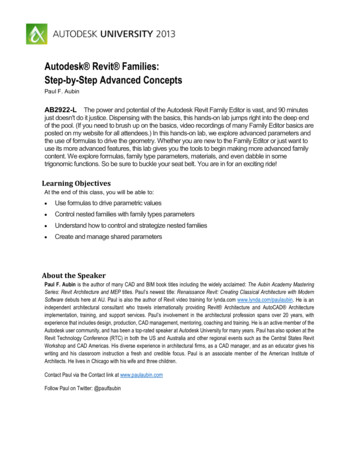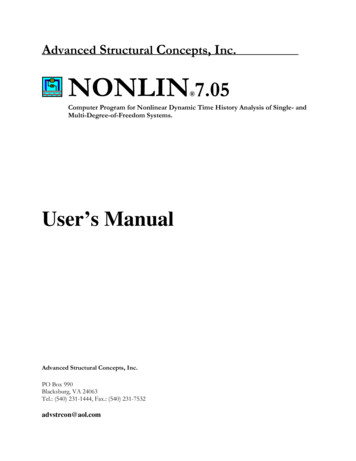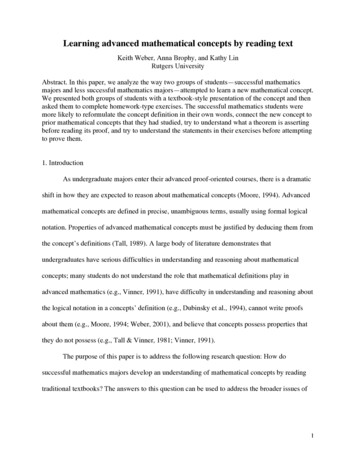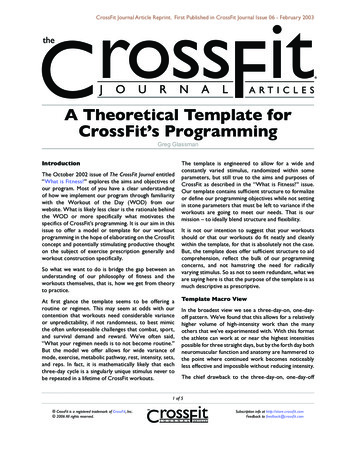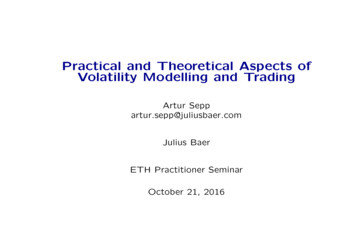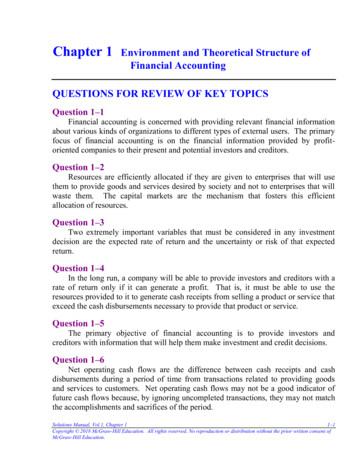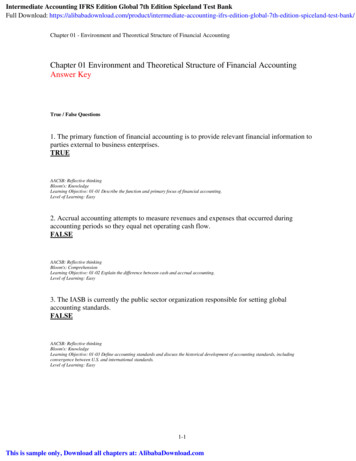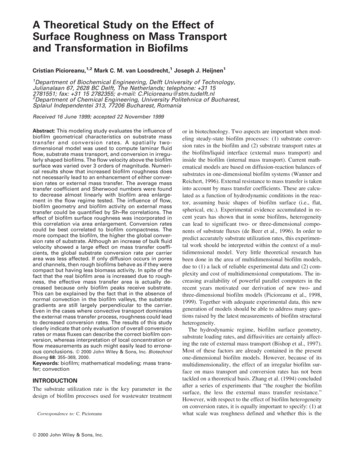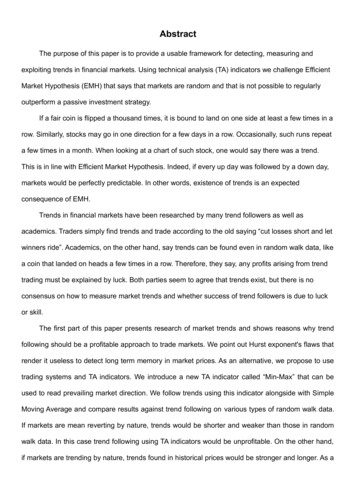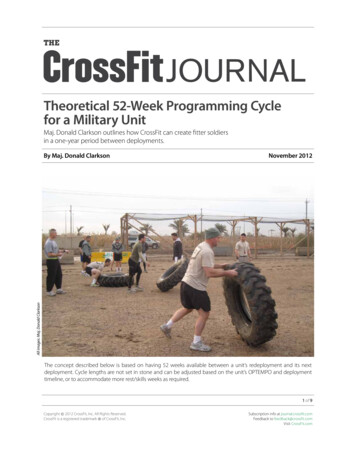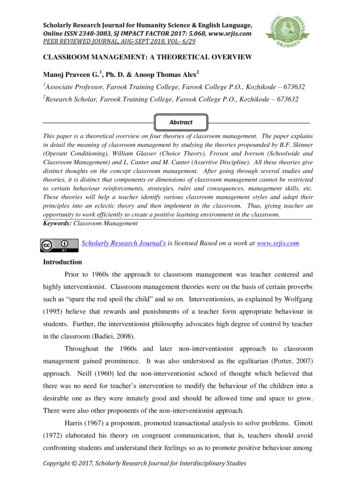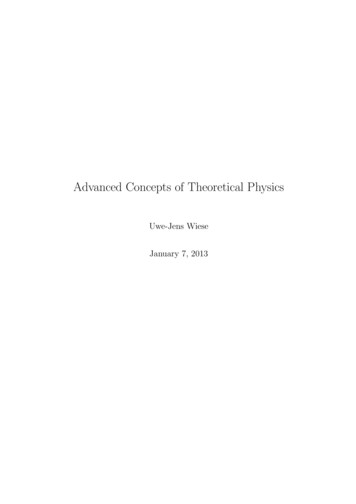
Transcription
Advanced Concepts of Theoretical PhysicsUwe-Jens WieseJanuary 7, 2013
Contents1 Introduction72 From Mechanics to Quantum Field Theory92.1From Point Mechanics to Classical Field Theory . . . . . . . . . . . .2.2The Path Integral in Real Time . . . . . . . . . . . . . . . . . . . . . 112.3The Path Integral in Euclidean Time . . . . . . . . . . . . . . . . . . 152.4Spin Models in Classical Statistical Mechanics . . . . . . . . . . . . . 162.5Quantum Mechanics versus Statistical Mechanics . . . . . . . . . . . 182.6The Transfer Matrix . . . . . . . . . . . . . . . . . . . . . . . . . . . 192.7Lattice Field Theory . . . . . . . . . . . . . . . . . . . . . . . . . . . 223 Lie Groups and Lie Algebras9253.1Definition of a Lie Algebra . . . . . . . . . . . . . . . . . . . . . . . . 253.2Simple and Semi-Simple Lie Algebras . . . . . . . . . . . . . . . . . . 273.3Representations of Lie Algebras . . . . . . . . . . . . . . . . . . . . . 273.4The Lie Algebra so(3) and its Representations . . . . . . . . . . . . . 283.5The Groups SU (2) and SO(3) . . . . . . . . . . . . . . . . . . . . . . 313.6The Unitary Group SU (n) and its Algebra . . . . . . . . . . . . . . . 333.7The Group SU (3) and its Algebra . . . . . . . . . . . . . . . . . . . . 341
2CONTENTS3.8The Permutation Group SN . . . . . . . . . . . . . . . . . . . . . . . 373.9Coupling of su(n) Representations . . . . . . . . . . . . . . . . . . . . 403.10 Coupling of {3} and {3} in su(3) . . . . . . . . . . . . . . . . . . . . 433.11 The Orthogonal Group SO(n) and its Algebra . . . . . . . . . . . . . 453.12 The Symplectic Group Sp(n) and its Algebra . . . . . . . . . . . . . 463.13 The Exceptional Group G(2) and its Algebra . . . . . . . . . . . . . . 484 Galilei, Lorentz, and Poincaré Algebras534.1The Galilei Algebra in One, Two, and Three Dimensions . . . . . . . 534.2Representation of the Galilei Algebra with Non-Relativistic Interacting Particles . . . . . . . . . . . . . . . . . . . . . . . . . . . . . . . . 554.3The Poincaré Algebra in One, Two, and Three Dimensions . . . . . . 554.4Free Spinless Particles . . . . . . . . . . . . . . . . . . . . . . . . . . 584.5Free Particles with Spin . . . . . . . . . . . . . . . . . . . . . . . . . 594.6The Center of Energy . . . . . . . . . . . . . . . . . . . . . . . . . . . 605 Abelian and Non-Abelian Gauge Fields635.1From Abelian U (1) to Non-Abelian SU (2) Gauge Fields . . . . . . . 645.2SU (2)s U (1)em Gauge Symmetry of the Pauli Equation . . . . . . . 655.3Non-Abelian SU (2) Field Strength Tensor . . . . . . . . . . . . . . . 675.4General Non-Abelian Gauge Fields . . . . . . . . . . . . . . . . . . . 686 Topology of Gauge Fields716.1Maps from S d to S n6.2Homotopy Groups of Lie Group Manifolds . . . . . . . . . . . . . . . 736.3The Topological Charge of a 2-d Abelian Gauge Field . . . . . . . . . 756.4The Topological Charge of a 4-d Non-Abelian Gauge Field . . . . . . 76. . . . . . . . . . . . . . . . . . . . . . . . . . . 71
CONTENTS6.53The Instanton in SU (2) . . . . . . . . . . . . . . . . . . . . . . . . . 807 The Adiabatic Berry Phase8312in a Magnetic Field . . . . . . . . . 837.1Abelian Berry Phase of a Spin7.2Non-Abelian Berry Phase . . . . . . . . . . . . . . . . . . . . . . . . 867.3SO(3) Gauge Fields in Falling Cats . . . . . . . . . . . . . . . . . . . 887.4Final Remarks . . . . . . . . . . . . . . . . . . . . . . . . . . . . . . . 90A Angular Momentum in Quantum Mechanics93A.1 Angular Momentum Commutation Relations . . . . . . . . . . . . . . 93A.2 Coupling of Angular Momenta . . . . . . . . . . . . . . . . . . . . . . 95A.3 Coupling of Two Spins 1/2 . . . . . . . . . . . . . . . . . . . . . . . . 96A.4 Coupling of Orbital Angular Momentum and Spin . . . . . . . . . . . 98B The Constituent Quark Model101B.1 Isospin Symmetry . . . . . . . . . . . . . . . . . . . . . . . . . . . . . 101B.2 Nucleon and -Isobar in the Quark Model . . . . . . . . . . . . . . . 103B.3 Anti-Quarks and Mesons . . . . . . . . . . . . . . . . . . . . . . . . . 106B.4 Strange Hadrons . . . . . . . . . . . . . . . . . . . . . . . . . . . . . 108B.5 Gellman-Okubo Baryon Mass Formula . . . . . . . . . . . . . . . . . 110C Structure of Minkowski Space-Time113C.1 Lorentz Transformations . . . . . . . . . . . . . . . . . . . . . . . . . 113C.2 Gradient as a 4-Vector and d’Alembert Operator . . . . . . . . . . . . 116D Particle in an Electromagnetic Field119D.1 The Classical Electromagnetic Field . . . . . . . . . . . . . . . . . . . 119
4CONTENTSD.2 Classical Charged Particle in an External Electromagnetic Field . . . 121D.3 Gauge Invariant Form of the Schrödinger Equation . . . . . . . . . . 122E Relativistic Formulation of Classical Electrodynamics127E.1 Current and Vector Potential . . . . . . . . . . . . . . . . . . . . . . 127E.2 Field Strength Tensor . . . . . . . . . . . . . . . . . . . . . . . . . . . 129E.3 Maxwell Equations . . . . . . . . . . . . . . . . . . . . . . . . . . . . 130E.4 Space-Time Scalars from Field Strength Tensors . . . . . . . . . . . . 132E.5 Transformation of Electromagnetic Fields . . . . . . . . . . . . . . . . 133E.6 Action and Euler-Lagrange Equation . . . . . . . . . . . . . . . . . . 133E.7 Energy-Momentum Tensor . . . . . . . . . . . . . . . . . . . . . . . . 134F Why Physics Exists135F.1 Structures and Physicists . . . . . . . . . . . . . . . . . . . . . . . . . 135F.2 Space, Time, and Separable Entities . . . . . . . . . . . . . . . . . . . 136F.3 Space-Time Locality . . . . . . . . . . . . . . . . . . . . . . . . . . . 136F.4 Hierarchies of Scales . . . . . . . . . . . . . . . . . . . . . . . . . . . 137F.5 Anthropic Arguments . . . . . . . . . . . . . . . . . . . . . . . . . . . 137F.6 Effective Field Theory . . . . . . . . . . . . . . . . . . . . . . . . . . 137F.7 Renormalization Group, Universality, and the Benefit of 4-d . . . . . 138F.8 The Theory of Everything . . . . . . . . . . . . . . . . . . . . . . . . 138F.9 Model Building . . . . . . . . . . . . . . . . . . . . . . . . . . . . . . 139F.10 Numerical Simulation . . . . . . . . . . . . . . . . . . . . . . . . . . . 140F.11 Different Layers of Reality and Limits of Physics . . . . . . . . . . . . 140F.12 Understanding our own Brain . . . . . . . . . . . . . . . . . . . . . . 141F.13 Neuroscience as a “Theory of Everything” related to Neuronal Activity?141
CONTENTS5F.14 Matching the Mind and Matter Layers of Reality . . . . . . . . . . . 142F.15 Evolution, Brain Chemistry, and Physics . . . . . . . . . . . . . . . . 143F.16 Summary . . . . . . . . . . . . . . . . . . . . . . . . . . . . . . . . . 143
6CONTENTS
Chapter 1IntroductionTheoretical physics is the attempt to describe Nature quantitatively using the language of mathematics. Indeed there is an interplay between mathematics and theoretical physics, with both disciplines enriching each other. Isaac Newton inventedcalculus in order to apply it to classical mechanics. Michael Faraday developed thefield concept in order to describe electromagnetism. David Hilbert’s abstract spaceof square integrable functions turned out to be the home of quantum mechanicalwave functions. Paul Dirac “invented” the δ-function which motivated mathematicians to develop distribution theory. Abelian gauge symmetry was discovered asthe basic principle underlying Maxwell’s equations. Sophus Lie’s abstract conceptsof non-Abelian symmetry algebras and symmetry groups underlie Wolfgang Pauli’sideas about non-Abelian gauge symmetry, which were further developed by RobertMills and Chen-Ning Yang and were later discovered to form the basis of the strongand electroweak interactions. Michael Atiyah and Isidore Singer investigated thetopological properties of Dirac operators, which turned out to be essential in thecontext of anomalous symmetries in quantum field theory, which are present at theclassical level but cannot be maintained in the quantization process. Michael Berryrealized that topological features of wave functions play a central role in adiabaticprocesses in quantum mechanics and can be characterized by abstract Abelian andnon-Abelian gauge fields in the space of slowly varying external parameters. This listcould be extended much further, and the creative process of discovering new mathematics when thinking about Nature or using existing mathematics to describe itsobserved behavior is likely to continue for a long time.In this course, we will familiarize ourselves with some advanced mathematicalconcepts that are at the basis of the modern theories of particle and condensed matter physics, as well as of some advanced topics in quantum mechanics. Althoughthe subject is mathematical, we will by no means apply the rigor of a mathemati-7
8CHAPTER 1. INTRODUCTIONcian. Instead, we will concentrate on those aspects that are most relevant in physicsapplications. Consequently, we will avoid very abstract mathematical constructionsin favor of a hands-on practitioner’s approach. While we will aim at understanding the subject at a deep level, we will not attempt rigorous proofs, and we willsometimes even limit ourselves to applying specific procedures, for example, whenwe reduce products of SU (n) representations, without proving their validity. Whenwe discuss Lie algebras and Lie groups, as well as the topology of the correspondinggroup manifolds, we will focus on those aspects that are most important in physicalapplications. A systematic mathematical exposition of these subjects would go farbeyond the scope of the current course. For example, the concept of the Killingvector field of a Lie group manifold is not developed, although it does have physicalapplications. Although the presented material is neither mathematically rigorousnor complete, it will hopefully provide the reader with a solid basis for better understanding the quantum field theories that underlie modern particle physics as wellas some theories in condensed matter physics.It is a most fascinating aspect of physics that, on all lengths scales, Naturecan indeed be described mathematically. The most fundamental building blocks ofmatter, elementary particles such as electrons and photons, as well as quarks andgluons are precise embodiments of abstract mathematical concepts. Even on muchcoarser length scales the plateaus in the resistivity of a quantum Hall sample aremost precisely quantized in units of Planck’s quantum h and the elementary electriccharge e. Even the evolution of the entire cosmos is controlled rather precisely bythe differential equations derived from general relativity assuming the FriedmannLemaitre-Robertson-Walker metric. As I argue in an appendix to these lecturenotes, it is the locality of space and time and the existence of vast hierarchies ofdistance scales that leads to the success of physics and thus “explains” why physicsexists. In this course, we will familiarize ourselves with some important advancedconcepts of theoretical physics, in order to be better prepared to understand themodern theories of particle and condensed matter physics, as well as some aspectsof advanced quantum mechanics. This may even inspire us to “invent” our own newmathematics or to be creative when trying to describe some new aspect of Naturemathematically. Mathematics is a universal language spoken by curious minds andcapable brains, and used for various purposes, in particular, to communicate theabstract beauty of Nature. Let us learn more about this language and let us keepin mind that theoretical physics is a man- and women-made endeavor that relies onour curiosity as much as on our mathematical capabilities.
Chapter 2From Mechanics to QuantumField TheoryThis chapter provides a brief summary of the mathematical structure of quantumfield theory. Classical field theories are discussed as a generalization of point mechanics to systems with infinitely many degrees of freedom — a given number perspace point. Similarly, quantum field theories are just quantum mechanical systems with infinitely many degrees of freedom. In the same way as point mechanicssystems, classical field theories can be quantized with path integral methods. Thequantization of field theories at finite temperature leads to path integrals in Euclidean time. This provides us with an analogy between quantum field theory andclassical statistical mechanics. We also mention the lattice regularization which hasrecently provided a mathematically satisfactory formulation of the standard modelbeyond perturbation theory.2.1From Point Mechanics to Classical Field TheoryPoint mechanics describes the dynamics of classical nonrelativistic point particles.The coordinates of the particles represent a finite number of degrees of freedom.In the simplest case — a single particle moving in one spatial dimension — weare dealing with a single degree of freedom: the x-coordinate of the particle. Thedynamics of a particle of mass m moving in an external potential V (x) is described9
10CHAPTER 2. FROM MECHANICS TO QUANTUM FIELD THEORYby Newton’s equationm t2 x ma F (x) dV (x).dx(2.1.1)Once the initial conditions are specified, this ordinary second order differential equation determines the particle’s path x(t), i.e. its position as a function of time. Newton’s equation results from the variational principle to minimize the actionZS[x] dt L(x, t x),(2.1.2)over the space of all paths x(t). The action is a functional (a function whose argument is itself a function) that results from the time integral of the Lagrange functionL(x, t x) m( t x)2 V (x).2(2.1.3)The Euler-Lagrange equation tδLδL 0,δ( t x) δx(2.1.4)is nothing but Newton’s equation.Classical field theories are a generalization of point mechanics to systems withinfinitely many degrees of freedom — a given number for each space point x. In thiscase, the degrees of freedom are the field values φ( x), where φ is some generic field.In case of a neutral scalar field, φ is simply a real number representing one degreeof freedom per space point. A charged scalar field, on the other hand, is describedby a complex number and hence represents two degrees of freedom per space point.The scalar Higgs field φa ( x) (with a {1, 2}) in the standard model is a complexdoublet, i.e. it has four real degrees of freedom per space point. An Abelian gaugefield Ai ( x) (with a spatial direction index i {1, 2, 3}) — for example, the photonfield in electrodynamics — is a neutral vector field with 3 real degrees of freedomper space point. One of these degrees of freedom is redundant due to the U (1)emgauge symmetry. Hence, an Abelian gauge field has two physical degrees of freedomper space point which correspond to the two polarization states of the masslessphoton. Note that the time-component A0 ( x) does not represent a physical degreeof freedom. It is just a Lagrange multiplier field that enforces the Gauss law. A nonAbelian gauge field Aai ( x) is charged and has an additional index a. For example,the gluon field in chromodynamics with a color index a {1, 2, ., 8} represents2 8 16 physical degrees of freedom per space point, again because of someredundancy due to the SU (3)c color gauge symmetry. The field that represents theW - and Z-bosons in the standard model has an index a {1, 2, 3} and transformsunder the gauge group SU (2)L . Thus, it represents 2 3 6 physical degrees of
2.2. THE PATH INTEGRAL IN REAL TIME11freedom. However, in contrast to the photon, the W - and Z-bosons are massivedue to the Higgs mechanism and have three (not just two) polarization states. Theextra degree of freedom is provided by the Higgs field.The analog of Newton’s equation in field theory is the classical field equation ofmotion. For example, for a neutral scalar field this is the Klein-Gordon equation µ µ φ dV (φ).dφ(2.1.5)Again, after specifying appropriate initial conditions it determines the classical fieldconfiguration φ(x), i.e. the values of the field φ at all space-time points x (t, x).Hence, the role of time in point mechanics is played by space-time in field theory,and the role of the point particle coordinates is now played by the field values. Asbefore, the classical equation of motion results from minimizing the actionZS[φ] d4 x L(φ, µ φ).(2.1.6)The integral over time in eq.(2.1.2) is now replaced by an integral over space-timeand the Lagrange function of point mechanics gets replaced by the Lagrange densityfunction (or Lagrangian)1L(φ, µ φ) µ φ µ φ V (φ).2(2.1.7)A simple interacting field theory is the φ4 theory with the potentialV (φ) m2 2 λ 4φ φ.24!(2.1.8)Here m is the mass of the scalar field and λ is the coupling strength of its selfinteraction. Note that the mass term corresponds to a harmonic oscillator potentialin the point mechanics analog, while the interaction term corresponds to an anharmonic perturbation. As before, the Euler-Lagrange equation µδLδL 0,δ( µ φ) δφ(2.1.9)is the classical equation of motion, in this case the Klein-Gordon equation. Theanalogies between point mechanics and field theory are summarized in table 2.1.2.2The Path Integral in Real TimeThe quantization of field theories is most conveniently performed using the pathintegral approach. Here we first discuss the path integral in quantum mechanics
12CHAPTER 2. FROM MECHANICS TO QUANTUM FIELD THEORYPoint Mechanicstime tparticle coordinate xparticle pathx(t)Raction S[x] dt L(x, t x)Lagrange functionL(x, t x) m2 ( t x)2 V (x)equation of motion t δ( δLt x) δL 0δxNewton’s equation t2 x dVdx(x)kinetic energy m2 ( t x)2harmonic oscillator potential m2 ω 2 x2anharmonic perturbation 4!λ x4Field Theoryspace-time x (t, x)field value φfield configurationφ(x)R 4action S[φ] d x L(φ, µ φ)LagrangianL(φ, µ φ) 12 µ φ µ φ V (φ)field equation µ δ( δLµ φ) δL 0δφKlein-Gordon equation µ µ φ dVdφ(φ)kinetic energy 12 µ φ µ φ2mass term m2 φ2self-interaction term 4!λ φ4Table 2.1: The dictionary that translates point mechanics into the language of fieldtheory.— quantized point mechanics — using the real time formalism. A mathematicallymore satisfactory formulation uses an analytic continuation to so-called Euclideantime. This will be discussed in the next section.The real time evolution of a quantum system described by a Hamilton operatorH is given by the time-dependent Schrödinger equationi t Ψ(t)i H Ψ(t)i.(2.2.1)For a time-independent Hamilton operator the time evolution operator is given byiU (t0 , t) exp( H(t0 t)), (2.2.2) Ψ(t0 )i U (t0 , t) Ψ(t)i.(2.2.3)such thatLet us consider the transition amplitude hx0 U (t0 , t) xi of a nonrelativistic pointparticle that starts at position x at time t and arrives at position x0 at time t0 .Usinghx Ψ(t)i Ψ(x, t)(2.2.4)we obtain00Ψ(x , t ) Zdx hx0 U (t0 , t) xiΨ(x, t),(2.2.5)
2.2. THE PATH INTEGRAL IN REAL TIME13i.e. hx0 U (t0 , t) xi acts as a propagator for the wave function. The propagator is ofphysical interest because it contains information about the energy spectrum. Whenwe consider propagation from an initial position x back to the same position we findihx U (t0 , t) xi hx exp( H(t0 t)) xi Xi hx ni 2 exp( En (t0 t)). nWe have inserted a complete set,Pn(2.2.6) nihn 1I, of energy eigenstates ni withH ni En ni.(2.2.7)Hence, according to eq.(2.2.6), the Fourier transform of the propagator yields theenergy spectrum as well as the energy eigenstates hx ni.Inserting a complete set of position eigenstates we arrive atihx0 U (t0 , t) xi hx0 exp( H(t0 t1 t1 t)) xi Zi0 dx1 hx exp( H(t0 t1 )) x1 i i hx1 exp( H(t1 t)) xi Z dx1 hx0 U (t0 , t1 ) x1 ihx1 U (t1 , t) xi.(2.2.8)It is obvious that we can repeat this process an arbitrary number of times. This isexactly what we do in the formulation of the path integral. Let us divide the timeinterval [t, t0 ] into N elementary time steps of size ε such thatt0 t N ε.(2.2.9)Inserting a complete set of position eigenstates at the intermediate times ti , i {1, 2, ., N 1} we obtainZZZ00hx U (t , t) xi dx1 dx2 . dxN 1 hx0 U (t0 , tN 1 ) xN 1 i. hx2 U (t2 , t1 ) x1 ihx1 U (t1 , t) xi.(2.2.10)In the next step we concentrate on one of the factors and we consider a singlenonrelativistic point particle moving in an external potential V (x) such thatH p2 V (x).2m(2.2.11)
14CHAPTER 2. FROM MECHANICS TO QUANTUM FIELD THEORYUsing the Baker-Campbell-Haussdorff formula and neglecting terms of order ε2 wefindiεp2iεhxi 1 U (ti 1 , ti ) xi i hxi 1 exp( ) exp( V (x)) xi i2m Ziε1iεp2) pihp exp( V (x)) xi i dphxi 1 exp( 2π2m Z21iiεp ) exp( p(xi 1 xi ))dp exp( 2π2m iε(2.2.12) exp( V (xi )). The integral over p is ill-defined because the integrand is a very rapidly oscillatingfunction. To make the expression well-defined we replace the time step ε by ε ia,i.e. we go out into the complex time plane. After doing the integral we take thelimit a 0. Still one should keep in mind that the definition of the path integralrequired an analytic continuation in time. One findsri m xi 1 xi 2mexp( ε[ () V (xi )]).(2.2.13)hxi 1 U (ti 1 , ti ) xi i 2πi ε 2εInserting this back into the expression for the propagator we obtainZi00hx U (t , t) xi Dx exp( S[x]). The action has been identified in the time continuum limit asZmS[x] dt [ ( t x)2 V (x)]2X m xi 1 xi limε[ ()2 V (xi )].ε 02εi(2.2.14)(2.2.15)The integration measure is defined asrZDx limε 0m2πi εNZZdx1Zdx2 .dxN 1 .(2.2.16)This means that we integrate over the possible particle positions for each intermediate time ti . In this way we integrate over all possible paths of the particle starting atx and ending at x0 . Each path is weighted with an oscillating phase factor exp( i S[x])determined by the action. The classical path of minimum action has the smallestoscillations, and hence the largest contribution to the path integral. In the classicallimit 0 only that contribution survives.
2.3. THE PATH INTEGRAL IN EUCLIDEAN TIME2.315The Path Integral in Euclidean TimeAs we have seen, it requires a small excursion into the complex time plane to makethe path integral mathematically well-defined. Now we will make a big step intothat plane and actually consider purely imaginary so-called Euclidean time. Thephysical motivation for this, however, comes from quantum statistical mechanics.Let us consider the quantum statistical partition functionZ Tr exp( βH),(2.3.1)where β 1/T is the inverse temperature. It is mathematically equivalent to thetime interval we discussed in the real time path integral. In particular, the operatorexp( βH) turns into the time evolution operator U (t0 , t) if we identifyi 0(t t).(2.3.2) In this sense the system at finite temperature corresponds to a system propagatingin purely imaginary (Euclidean) time. By dividing the Euclidean time interval intoN time steps, i.e. by writing β N a/ , and again by inserting complete sets ofposition eigenstates we now arrive at the Euclidean time path integralZ1(2.3.3)Z Dx exp( SE [x]). β The action now takes the Euclidean formZmSE [x] dt [ ( t x)2 V (x)]2X m xi 1 xi)2 V (xi )]. lima[ (a 02aiIn contrast to the real time case the measure now involves N integrationsrZZZN ZmDx limdx1 dx2 . dxN .a 02π a(2.3.4)(2.3.5)The extra integration over xN x0 is due to the trace in eq.(2.3.1). Note that thereis no extra integration over x0 x because the trace implies periodic boundaryconditions in the Euclidean time direction, i.e. x0 xN .The Euclidean path integral allows us to evaluate thermal expectation values.For example, let us consider an operator O(x) that is diagonal in the position statebasis. We can insert this operator in the path integral and thus compute its expectation valueZ111hO(x)i Tr[O(x) exp( βH)] Dx O(x(0)) exp( SE [x]).(2.3.6)ZZ
16CHAPTER 2. FROM MECHANICS TO QUANTUM FIELD THEORYSince the theory is translation invariant in Euclidean time one can place the operator anywhere in time, e.g. at t 0 as done here. When we perform the lowtemperature limit, β , the thermal fluctuations are switched off and only thequantum ground state 0i (the vacuum) contributes to the partition function, i.e.Z exp( βE0 ). In this limit the path integral is formulated in an infinite Euclideantime interval, and describes the vacuum expectation valueZ11(2.3.7)Dx O(x(0)) exp( SE [x]).hO(x)i h0 O(x) 0i limβ Z It is also interesting to consider 2-point functions of operators at different instancesin Euclidean time1Tr[O(x) exp( Ht)O(x) exp(Ht) exp( βH)]ZZ11 Dx O(x(0))O(x(t)) exp( SE [x]).(2.3.8)Z hO(x(0))O(x(t))i Again, we consider the limit β , but we also separate the operators in time,i.e. we also let t . Then the leading contribution is h0 O(x) 0i 2 . Subtractingthis, and thus forming the connected 2-point function, one obtainslim hO(x(0))O(x(t))i hO(x)i 2 h0 O(x) 1i 2 exp( (E1 E0 )t).β,t (2.3.9)Here 1i is the first excited state of the quantum system with an energy E1 . Theconnected 2-point function decays exponentially at large Euclidean time separations.The decay is governed by the energy gap E1 E0 . In a quantum field theory E1corresponds to the energy of the lightest particle. Its mass is determined by theenergy gap E1 E0 above the vacuum. Hence, in Euclidean field theory particlemasses are determined from the exponential decay of connected 2-point correlationfunctions.2.4Spin Models in Classical Statistical MechanicsSo far we have considered quantum systems both at zero and at finite temperature. We have represented their partition functions as Euclidean path integrals overconfigurations on a time lattice of length β. We will now make a completely newstart and study classical discrete systems at finite temperature. We will see thattheir mathematical description is very similar to the path integral formulation ofquantum systems. Still, the physical interpretation of the formalism is drastically
2.4. SPIN MODELS IN CLASSICAL STATISTICAL MECHANICS17different in the two cases. In the next section we will set up a dictionary that allowsus to translate quantum physics language into the language of classical statisticalmechanics.For simplicity, let us concentrate on simple classical spin models. Here the wordspin does not mean that we deal with quantized angular momenta. All we do iswork with classical variables that can point in specific directions. The simplest spinmodel is the Ising model with classical spin variables sx 1. (Again, these donot represent the quantum states up and down of a quantum mechanical angularmomentum 1/2.) More complicated spin models with an O(N ) spin rotationalsymmetry are the XY model (N 2) and the Heisenberg model (N 3). The spinsin the XY model are 2-component unit-vectors, while the spins in the Heisenbergmodel have three components. In all these models the spins live on the sites ofa d-dimensional spatial lattice. The lattice is meant to be a crystal lattice (sotypically d 3) and the lattice spacing has a physical meaning. This is in contrastto the Euclidean time lattice that we have introduced to make the path integralmathematically well-defined, and that we finally send to zero in order to reach theEuclidean time continuum limit. The Ising model is characterized by its classicalHamilton function (not a quantum Hamilton operator) which simply specifies theenergy of any configuration of spins. The Ising Hamilton function is a sum of nearestneighbor contributionsXXH[s] Jsx sy µBsx ,(2.4.1)hxyixwith a ferromagnetic coupling constant J 0 that favors parallel spins, plus acoupling to an external magnetic field B. The classical partition function of thissystem is given byZY XZ Ds exp( H[s]/T ) exp( H[s]/T ).(2.4.2)x sx 1The sum over all spin configurations corresponds to an independent summationover all possible orientations of individual spins. Thermal averages are computedby inserting appropriate operators. For example, the magnetization is given byhsx i 1Y Xsx exp( H[s]/T ).Z x s 1(2.4.3)xSimilarly, the spin correlation function is defined byhsx sy i 1Y Xsx sy exp( H[s]/T ).Z x s 1x(2.4.4)
18CHAPTER 2. FROM MECHANICS TO QUANTUM FIELD THEORYAt large distances the connected spin correlation function typically decays exponentiallyhsx sy i hsi2 exp( x y /ξ),(2.4.5)where ξ is the so-called correlation length. At general temperatures the correlationlength is typically just a few lattice spacings. When one models real materials, theIsing model would generally be a great oversimplification, because real magnets, forexample, not only have nearest neighbor couplings. Still, the details of the Hamiltonfunction at the scale of the lattice spacing are not always important. There is acritical temperature Tc at which ξ diverges and universal behavior arises. At thistemperature a second order phase transition occurs. Then the details of the modelat the scale of the lattice spacing are irrelevant for the long range physics that takesplace at the scale of ξ. In fact, at their critical temperatures some real materialsbehave just like the simple Ising model. This is why the Ising model is so interesting.It is just a very simple member of a large universality class of different models, whichall share the same critical behavior. This does not mean that they have the samevalues of their critical temperatures. However, their magnetization goes to zero atthe critical temperature with the same power of Tc T , i.e. their critical exponentsare identical.2.5Quantum Mechanics versus Statistical MechanicsWe notice a close analogy between the Euclidean path integral for a quantum mechanical system and a classical statistical mechanics system like the Ising model.The path integral for the quantum system is defined on a 1-dimensional Euclideantime lattice, just like an Ising model can be defined on a d-dimensional spatial lattice. In the path integral we integrate over all paths, i.e. over all configurations
In this course, we will familiarize ourselves with some advanced mathematical concepts that are at the basis of the modern theories of particle and condensed mat-ter physics, as well as of some advanced topics in quantum mechanics. Although the subject is mathematical

